|
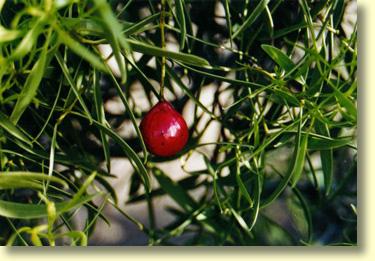
A single Quandong Berry
Santalum Acuminatum or the Quandong
The Quandong is a truly unique native Australian
fruit. Found in the arid and semi-arid regions of all Australian mainland
states , Quandong trees have been classified as belonging to the santalum
genus of plants. Ideally adapted to arid environments, the Santalum
Acuminatum species is known to be a semi-parasitic plant. Quandong
trees can tolerate high soil salinity levels and often rely for their
complete water requirements from the root systems of host plants.
Across their native distribution range, Quandong trees typically grow
2 to 3 metres in height, with a dense leathery crown of leaves perhaps
2 metres wide.
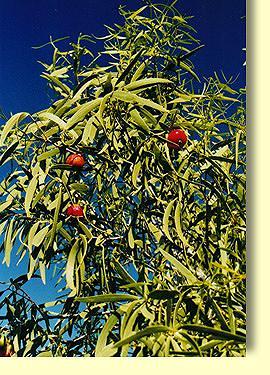
A Quandong Tree in Fruit
Aboriginal Bush Tucker
Traditionally the Quandong was an important
food source for Australian Aborigines. Amongst male members of central
Australia's Pitjantjara people, Quandongs were considered a suitable
substitute for meat - especially when hunting game was in short supply.
Around the Everard Ranges, Quandong gathering and food preparation
was considered Pitjantjara women's business. Ripe red Quandong fruits
would be eaten raw or dried for later use. Typically Everard Ranges
women would collect Quandongs in bark dishes, separate the edible
fruit from the pitted stone, and then roll the edible fruit into a
ball. The Quandong ball was then broken up for consumption by the
tribal group.
Medicinal Uses of the Quandong
Amongst Australian aborigines Quandongs
were much valued for their medicinal properties. Specialised
uses of the Quandong included a form of tea which was drunk as a purgative.
Quandong tree roots were also ground down and used as an infusion
for the treatment of rheumatism. Typically Quandong leaves were crushed
and mixed with saliva to produce a topical ointmnet for skin sores
and boils. Encased within each Quandong seed is an oil rich kernel
which was also processed in a similar fashion to treat skin disorders.
Quandong kernels could also be eaten and some tribal groups were known
to employ crushed kernels as a form of "hair conditioning oil". Ingeniously
Australia's aborigines appeared to be aware that Quandongs were a
preferred food source of emus, and that a ready supply of Quandong
seeds could be found in their droppings.
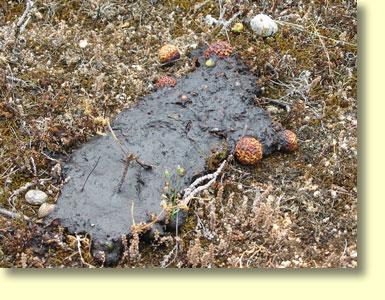
Emu Droppings and Quandong Seeds. Yum!
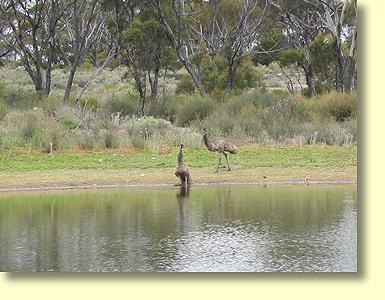
Western Australian Emus in Quandong country.
One of these emus is responsible for the above scat.
Our best guess is the thirsty one!
European Use of the Quandong
Australia's early pastoralists also discovered
their own unique uses for the Quandong. Away from homesteads for weeks
at a time, stockmen would often bake dampers infused with Quandong
leaves. The result was apparently a refreshing change from the usual
damper. When in season - between October and February - many farmers
would also take their families out for a Quandong picnic. After gathering
Quandongs the peeled fruit was used to make a variety of jams, chutneys
and Quandong pies. Such treats were often the only delicacies to be
had - especially during drought and depression years when money was
short. Today successive generations of rural Australians continue
with their Quandong picking traditions. They often do so however,
in contravention of state laws that prohibit the harvesting of wild
Quandongs. In all truth it seems old habits die hard, and for many
people the forbidden fruit is all the more tasty because of it.
Domestication of the Quandong
During the past 30 years the Quandong has
become a firm favourite of Australia's burgeoning bush food industry.
Commercial Quandong plantations are now an economic reality. True
domestication of the Santalum Acuminatum species remains some way
off however - not altogether surprising given that established fruit
varieties such as apples have been undergoing continuous selection
and development for thousands of years. Since 1973 Australia's CSIRO
has been actively conducting scientific research into developing improved
commercial Quandong cultivars.
The aim of such research has been to produce
a bright red Quandong with good eye appeal, improved flesh texture,
and a palatable mix of Quandong flavours, tannins and food acids.
To date the quest for the perfect Quandong has proven elusive. Should
CSIRO be successful however, then the Quandong will have become only
the second Australian food plant species to have been successfully
domesticated. Bring it on CSIRO!
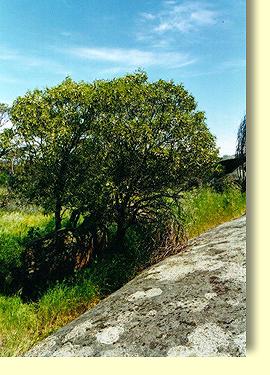
Quandong Tree at Pildappa Rock, SA
Queer Quandong Facts
- Fossilised Quandongs have been discovered in the coal seams
of Southern Victoria. Apparently these fossils date from 40 million
years ago - a time when Australia was still linked to the Antarctic
continent.
- Australian people often refer to Quandongs
as the Wild Peach, Desert Peach or Native Peach.
- Quandongs have a vitamin C content
higher than oranges and and almost certainly saved many early
Australian explorers from scurvy.
- Quandong fruit can be dried and frozen
for 8 years or more, without losing any flavour whatsoever.
- Quandong trees possess an aromatic
wood that was traditionally used by aboriginal people in "smoking
ceremonies".
- Rural Australian children often used
Quandong seeds as Chinese Checker pieces.
- The President of the New York Explorers
Club once imported Quandongs for one of their annual dinners -
along with some Polar Ice!
- To date
the only Australian food plant to be successfully domesticated
is the Macadamia Nut.The Macadamia Nut was successfully
domesticated in Hawaii. Will the Quandong be the second domesticated
food plant?
|









